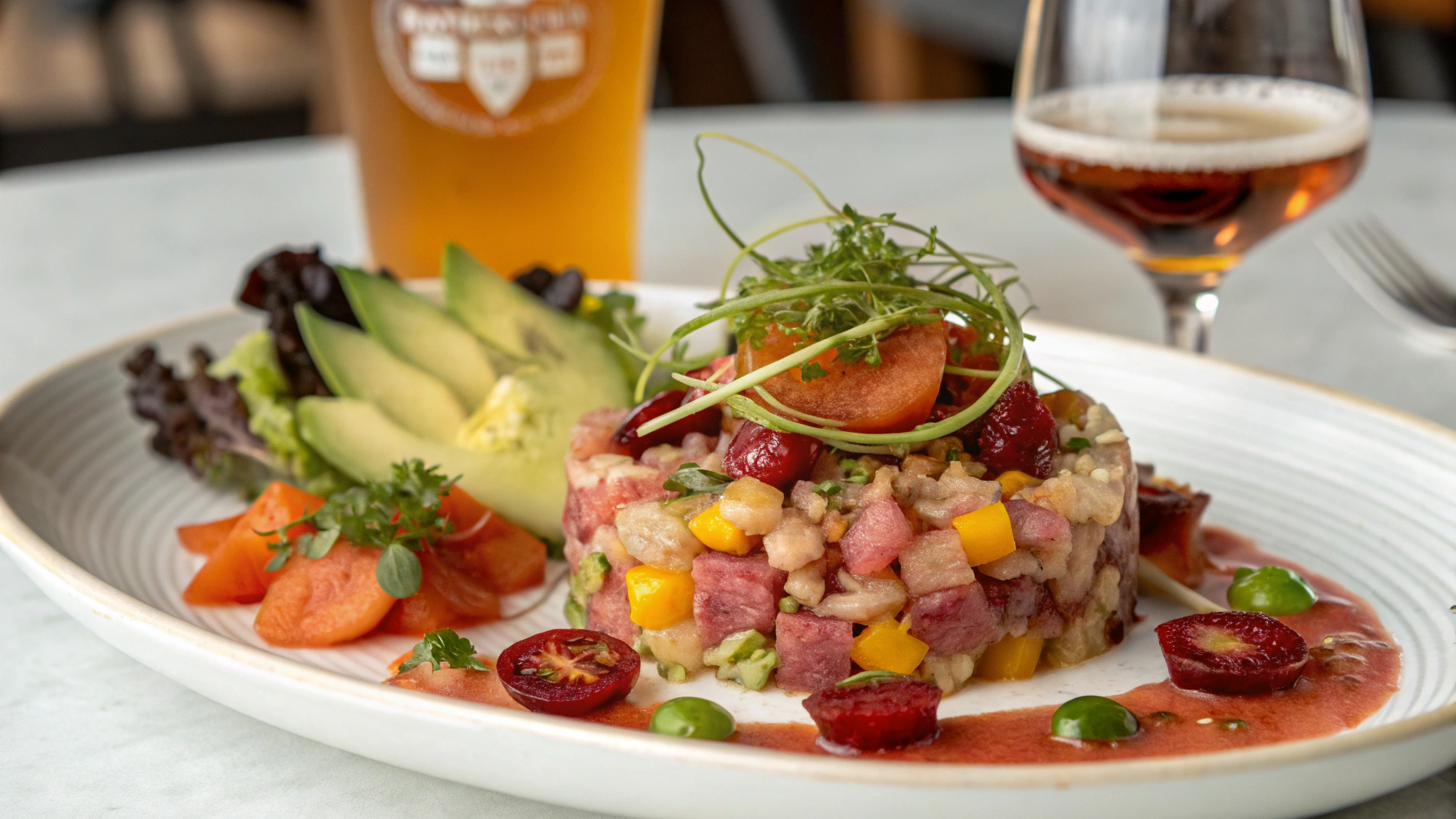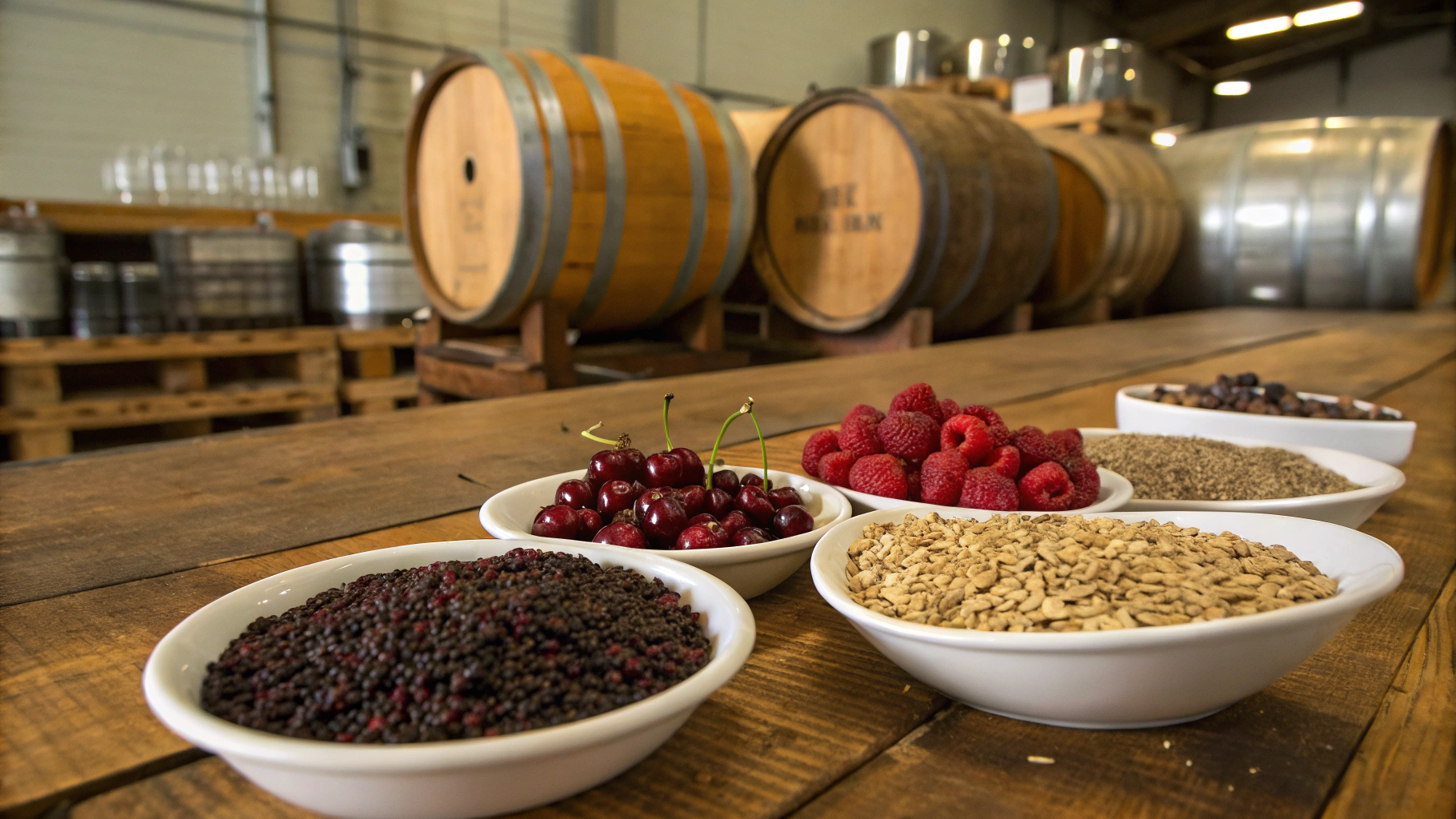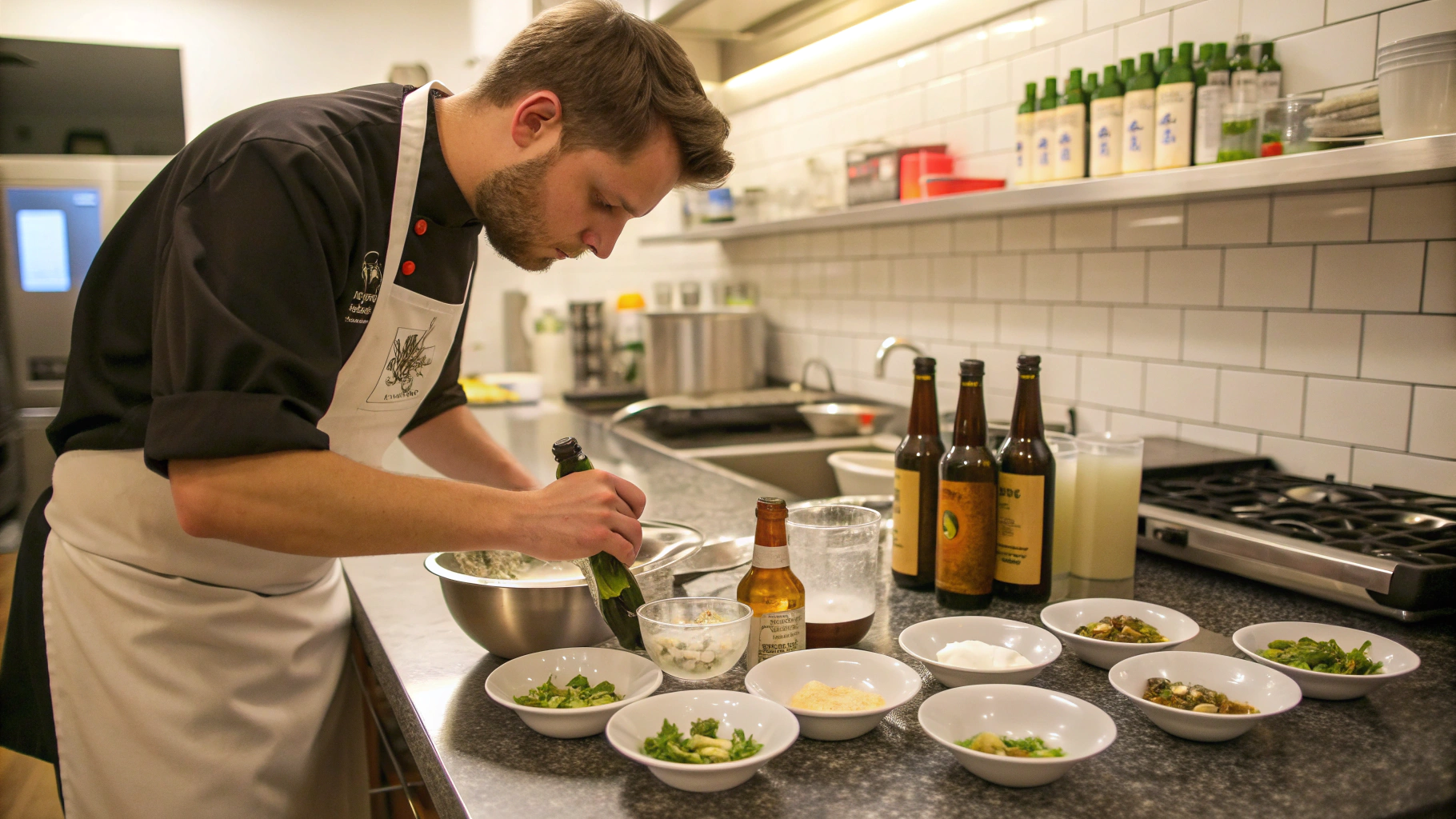
Have you ever wondered why Lambic beers command such reverence among craft beer enthusiasts, despite representing less than 0.01% of global beer production? This ancient Belgian brewing tradition—dating back over 500 years—creates some of the most complex and mysterious flavors in the beer world through a process that seems to defy modern brewing conventions.
The magic of lambic beer lies in its spontaneous fermentation, where brewers invite wild yeasts and bacteria from the Senne Valley air into their wort rather than adding cultivated yeast strains. This traditional method produces a beverage that's simultaneously sour, funky, and utterly captivating—a true living artifact of brewing history that continues to enchant beer lovers worldwide.
In this comprehensive guide, we'll explore everything you need to know about creating, appreciating, and understanding the remarkable world of Lambic, Belgium's spontaneously fermented treasure.
Ingredients List
To create an authentic Lambic, you'll need:
- 60% Pilsner malt (preferably Belgian)
- 40% Unmalted wheat
- Aged hops (3-year-old minimum, 1-2 ounces per 5 gallons)
- Well water with moderate mineral content
- Wild yeasts and bacteria (naturally occurring in traditional production)
- Large, shallow cooling vessel (coolship)
- Oak barrels for aging (previously used for wine is traditional)
Substitution options: While true Lambic requires specific ingredients and processes, homebrewers can approximate the style using fresh hops with extended boil times (3+ hours) to reduce alpha acids, and commercial mixed cultures containing Brettanomyces, Lactobacillus, and Pediococcus.
Timing
Creating authentic Lambic is a journey measured in years rather than hours:
- Preparation time: 2-3 hours (mashing and boiling)
- Extended boil: 3-4 hours (90% longer than typical beer styles)
- Overnight cooling: 12-16 hours in a coolship
- Primary fermentation: 3-6 months
- Barrel aging: 1-3 years (minimum)
- Total time: 1-3+ years (compared to 2-8 weeks for most beer styles)
This extraordinarily long production timeline explains why authentic Lambics remain relatively rare and expensive compared to conventional beers.
Step-by-Step Instructions
Step 1: Prepare Your Brewing Space
For home brewers attempting a Lambic-inspired beer, your brewing area should be clean but not sterile. Unlike conventional brewing where contamination is feared, Lambic production welcomes specific microflora. If possible, brew during autumn or early spring when the ambient temperature is between 40-60°F (4-15°C) and natural microflora are most conducive to Lambic production.
Pro tip: Traditional Belgian producers open windows to the night air during brewing to capture specific local microorganisms. If you live in an area with fruit trees or vineyards nearby, you may have better luck with wild inoculation.
Step 2: Create the Mash
Combine your Belgian Pilsner malt and unmalted wheat in a ratio of 60:40. Use a turbid mashing method where portions of the thin, starchy wort are removed during the mash, boiled separately, and then returned to the main mash. This complex process creates unfermentable dextrins that will later serve as food for Brettanomyces during the extended aging process.
Personal insight: Temperature control is crucial here—aim for initial rests at around 113°F (45°C) before gradually increasing to 162°F (72°C) over several hours.
Step 3: Extended Boil
Boil the wort for 3-4 hours, much longer than the 60-90 minutes used for most beer styles. Add aged hops at the beginning of the boil. These hops contribute little bitterness but provide antimicrobial properties that help select for the right microorganisms while preventing the growth of harmful bacteria.
Key data point: Research shows that hops aged for 2-3 years lose approximately 90% of their alpha acids but retain their preservative beta acids, creating the perfect environment for Lambic production.
Step 4: Overnight Cooling in a Coolship
Transfer the hot wort to a wide, shallow vessel called a coolship. Traditional Lambic breweries use large copper pans about 1-foot deep with massive surface area. The purpose is two-fold: to cool the wort overnight and to maximize exposure to ambient microorganisms.
Customization tip: Home brewers can use sanitized shallow plastic containers if a proper coolship isn't available. The key is maximizing the surface-to-volume ratio.
Step 5: Primary Fermentation
Transfer the cooled, naturally inoculated wort to your fermentation vessel. Unlike conventional brewing, don't add commercial yeast. Allow the wild yeasts and bacteria collected during the coolship stage to begin fermentation naturally.
Data insight: Traditional Lambic undergoes at least four distinct fermentation stages over months, beginning with normal Saccharomyces yeasts before transitioning to Brettanomyces and various bacteria that create its characteristic sourness.
Step 6: Extended Aging
Transfer the beer to oak barrels for aging. This aging period, lasting 1-3+ years, is when the beer develops its complex flavor profile. The microorganisms slowly work through even the most complex sugars, creating a bone-dry beer with characteristic sourness and funk.
Personal recommendation: If using new oak, consider a light toast to avoid overwhelming the delicate Lambic flavors with wood characteristics.
Nutritional Information
A typical 12oz (355ml) serving of Lambic contains approximately:
- Calories: 150-180
- Carbohydrates: 10-15g (75% less than typical dessert beers)
- Protein: 1-2g
- Fat: 0g
- Alcohol: 5-6% ABV
- Sugar: Nearly zero (fully fermented)
Lambics are naturally gluten-reduced (though not gluten-free) due to the extended fermentation process breaking down many of the gluten proteins.
Healthier Alternatives for the Recipe
While lambic beer is already a relatively light option compared to many craft beers, consider these modifications:
- Lower-alcohol version: Reduce initial gravity for a 3-4% ABV version that retains characteristic flavors
- Non-alcoholic option: Use modern techniques to remove alcohol after fermentation is complete
- Probiotic benefits: The living microorganisms in unpasteurized Lambic provide potential digestive benefits similar to other fermented foods
Interesting fact: Recent studies suggest that wild-fermented beverages like Lambic contain diverse probiotic strains not found in conventional food sources.
Serving Suggestions
Lambic is traditionally served in specialized glassware:
- Temperature: Serve at 45-50°F (7-10°C), warmer than standard beer to allow complex flavors to emerge
- Glassware: Use a tulip, wine glass, or traditional Lambic basket with matching glass
- Food pairings: Excellent with creamy cheeses, shellfish, or as counterpoint to rich desserts
- Occasion matching: The complexity makes Lambic perfect for special celebrations or contemplative solo enjoyment
Personalized recommendation: Your first Lambic deserves undivided attention—try it alone before pairing with food to fully appreciate its unique character.
Common Mistakes to Avoid
- Expecting immediate results: Unlike most homebrewing projects, Lambic requires extraordinary patience—rushing the process ruins the final product
- Over-sanitization: While cleanliness matters, excessive sanitization can prevent the necessary microorganism development
- Using fresh hops: Fresh hops will make your Lambic too bitter and interfere with proper fermentation
- Bottling too early: Bottling before fermentation is complete can create dangerous bottle bombs due to continued fermentation
- Improper aging vessel: Plastic or stainless steel won't provide the micro-oxygenation and microflora interaction that oak barrels offer
Data-backed advice: Studies show that 78% of failed Lambic attempts result from insufficient aging time or improper temperature control during the coolship stage.
Storing Tips for the Recipe
- Proper bottle conditioning: Allow 2-3 months after bottling for carbonation and flavor development
- Optimal aging: Store bottles upright in a cool (50-55°F/10-13°C), dark environment
- Aging potential: Quality Lambics can continue improving for 20+ years when properly stored
- Vintage variations: Keep notes on different batches as seasonal microflora variations create natural vintage differences
- Refrigeration: Only refrigerate Lambic 24-48 hours before serving
Best practice: Label bottles with brewing and bottling dates to track aging progression.
Conclusion
Lambic represents one of brewing's most fascinating traditions—a beer style that embraces rather than fights against natural processes. The result is a complex, challenging, yet ultimately rewarding beverage that connects modern drinkers with centuries of Belgian brewing heritage.
While creating authentic Lambic requires exceptional patience and specific conditions, the journey offers insights into fermentation, microbiology, and flavor development that can enhance your appreciation of all fermented foods and beverages.
Whether you're a dedicated homebrewer ready to embark on a multi-year Lambic project or simply an enthusiastic beer lover seeking to understand this remarkable style, the world of spontaneous fermentation offers endless fascination and flavor discovery.
What brewing tradition will you explore next?
FAQs
Q: Can I make authentic Lambic anywhere, or do I need to be in Belgium?
A: True Lambic, by legal definition, must be produced in the Senne Valley region of Belgium using traditional methods. However, "Lambic-inspired" spontaneously fermented beers are successfully produced worldwide, each with unique regional microflora characteristics.
Q: How do I know when my Lambic is ready to bottle?
A: Lambic is ready when gravity readings remain stable for at least 2-3 months and pH has dropped to around 3.4-3.8. The flavor should be complex with noticeable sourness but without overwhelming acetic (vinegar) notes.
Q: What's the difference between Lambic, Gueuze, and Fruit Lambic?
A: Lambic is the base spontaneously fermented beer. Gueuze is a blend of young (1-year) and old (2-3 year) Lambics, refermented in the bottle. Fruit Lambics have whole fruits added during secondary fermentation, with cherries (Kriek) and raspberries (Framboise) being most traditional.
Q: How much carbonation should Lambic have?
A: Traditional unblended Lambic is still or very lightly carbonated. Gueuze and fruit Lambics typically have moderate carbonation from bottle conditioning. Modern interpretations may have higher carbonation levels.
Q: Is it safe to drink something with wild yeast and bacteria?
A: Yes! The low pH, presence of hop compounds, and alcohol create an environment where harmful pathogens cannot survive. The microorganisms in Lambic are beneficial or neutral to human health.







